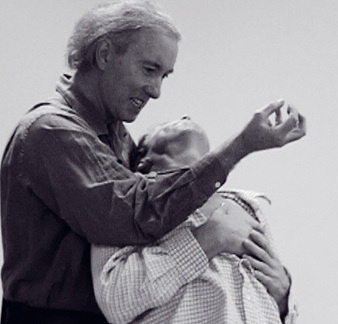THOUGHT/ACTION: THE DEATH OF AGENCY
Lower NZI, Level 1, Aotea Centre, Auckland
19/02/2012 - 19/02/2012
Production Details
Being both inside and outside the present moment, we find ourselves, one another and the world within shifting relationships which form our experiences. Thought/Action: The Death of Agency traverses through the experiences of living and dying, and how they intersect with the intensities of loss and redemption.
Thought/Action has travelled from Brussels to Amsterdam, Norway to Alice Springs, as well as the French countryside. Part of an ongoing series, The Death of Agency is a performance in movement and words, thought and action, by Amsterdam-based dancer and choreographer Frank van de Ven and Melbourne-based performance maker and writer Peter Snow. More about the artists »
“It was moving and beautifully wrought… and memorable.” Wendy Woodson,Amherst college,USA
Sunday 19 February: 7.45pm
DURATION: 60 minutes
VENUE: Lower NZI 3, Aotea Centre
TICKETS: $10
BOOKING: Book at THE EDGE
Quietly raw, challenging and non-confrontational
Review by Nik Smythe 20th Feb 2012
In the large unembellished Lower NZI function room with the large shiny white columns, two men take the stage, dressed unassumingly in black, white and grey tones similar to the venue’s hideous patterned grey carpet.
Peter is a gently spoken silver-haired chap in his late fifties, with a twinkle in his bespectacled eye and a cheeky little smile. Frank is younger, maybe mid thirties, intensely earnest in emotional tone, feverishly expressive in physical character.
Peter takes a seat and calmly observes Frank who hits the ground running, or pacing and fidgeting as it were. As Peter begins to speak, as though we’ve come in at the middle of something, his dulcet intonations trigger Frank’s wholly instinctive physical responses, and a curious form of language emerges.
While this is the work’s starting point and main structural basis, it’s not all Peter talks and Frank dances – Frank has occasion to volunteer his own vocal perspective and Peter is frequently moved to… well, move. And while the words and the thoughts they solicit normally direct the motion, at times the speaker is informed by the movement of the other.
Both speech and action advance in an engagingly natural flow that frequently sends gasps of insight and/or laughter through the intrigued audience.
Claiming their work to be 73% improvised, give or take, Peter directly addresses the question of what improvisation is (a way to answer difficult questions, come up with excuses, cook a meal with no food) implying that what we see here tonight is an inevitably original event, created by an established formula but resulting in an at least partially, if not largely, unique presentation.
From this notion we are taken on a journey through key points in mainly Peter’s life experience – his childhood, things his parents did and didn’t tell him, his friend Keith with whom he first practiced kissing. In physicalising these tales, Frank frequently exudes a distinct aura of intense struggle against contradictory forces both internal and external.
Matters are not averse to eruptions of conceptual grotesquery, as when a particularly odd train of thought leads to Peter swapping his heart for Frank’s brain. Overall the dimensions involved make it impossible to describe to any succinctly comprehensive degree, especially given it’ll be 73% different next time.
How relevant or significant to each of us and/or the world we live in Thought/Action is or could be, is ultimately a very personal thing – certainly there’s no strident message or overt political agenda or what have you. The main underlying point is the congenial opinion that ‘we are our relationships’, in that who we are is defined by the way we respond to other people and elements in our environment.
The simple, inelaborate design serves to minimize any distraction from the elements we are intended to be focused on, as advised in the title – the ideas, the movement, and the essential symbiosis between the two players whose anecdotes and philosophies are given added shape and substance by the nature of their intuitive interplay.
This deconstructed form is challenging inasmuch as it’s a new way of presenting ideas both basic and complex, but not demanding in any confrontational sense. Anyone pre-programmed to reject such abstract performance art as pretentious or airy-fairy may, with a little concentration, be surprised at the kinds of insight that emerges from this quietly raw style of theatre.
Copyright © in the review belongs to the reviewer






Comments